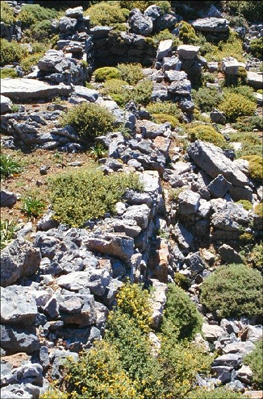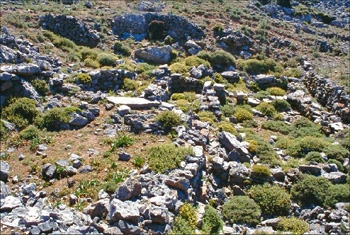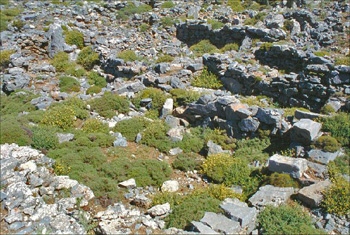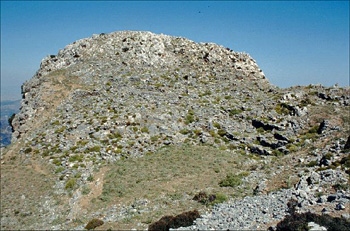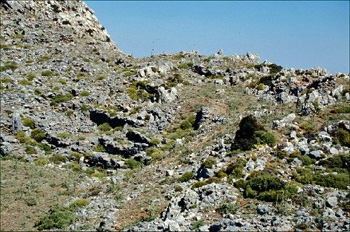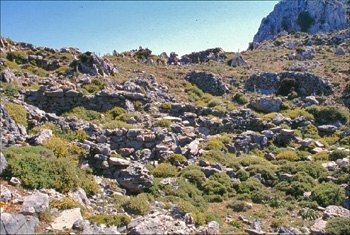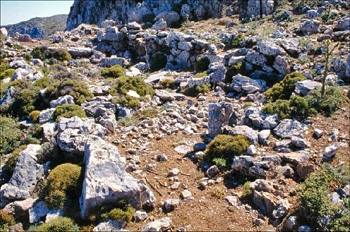A desperate setting for a desperate people
The refuge village of Karphi takes its name from the adjacent peak on the mountains surrounding the Lasithi Plain. It stands 1,100 metres above sea level. Today it is completely overgrown and it has suffered considerable erosion since the ground plans were drawn by the archaeologists (including J.D.S. Pendlebury) who excavated the site between 1937 and 1939. Consequently the original plan of the site is very difficult to discern on the ground as will be seen in the photographs below. Only one third of the site is thought to have been excavated. The site offers commanding views of the entrance to the Lasithi plain and north central Crete.
There was probably a Peak Sanctuary above the site during the Middle Minoan period. The refuge village dates from Late Minoan IIIC and may have continued in use into the sub-minoan period when it was finally abandoned. It was, in Hutchinson's words, "evidence of a gallant attempt by refugees of Minoan race, whose fathers had known better conditions, to construct something that might recall a small market town comparable to Gournia, but on a site that was exposed to bitter weather in winter and that had obviously been chosen for reasons of defence rather than of comfort."
The village
The population is estimated to have been about 3,500 and they lived by herding animals and hunting as well as cultivating olives at much lower altitudes than the village itself. The settlement is protected from the north wind which means that despite its altitude it could have been inhabited all the year, although it would have been an unpleasant place to live in the winter. Nevertheless the village had mainly single storey houses, paved streets and yards. Two cemeteries were located not far from the village near the two springs from which water was available. Remains of seventeen small tholos tombs were found around the Vitzelovrysis spring and four near the Astividero spring.
Cult activity
A number of locations in Karphi have been identified as the sites of cult activities. These included shrines of goddesses with upraised arms, areas which contained offering stands, rooms which contained figurines and rooms which contained libation vessels. Naturally some of these areas contained more than one type of ritual artefact. However it seems that different rituals were conducted in different parts of the village using different cult equipment. Thes rituals may have been conducted at different times of the year and they also differed from what has been observed at other LM IIIC sites.
Three buildings have been identified as housing the large terracotta statues of goddesses with upraised arms which are characteristic of this period. The first area was the Temple, a large rectangular area originally though to have been open but now thought to have been roofed with an open area adjacent to the building. Five goddess figures were found in the Temple, and three of these came from a bench built along the south side of the main room. Of the finds removed from the temple, many seem to have been for ritual use, including more heads of goddess figures, fragments of body parts, fragments of two animal figurines and a triton shell. Also found here were fragments of snake tubes, cylindrical stands, braziers and a firebox. Much of the remaining pottery was domestic and included a number of cooking vessels. It is not known if the food prepared there was offerings to the gods or for human consumption. A second shrine with goddess figures was located in the Commercial Quarter and a third in the Great House Shrine. This shrine is more problematic because it is located near a town dump. However it is interesting because of its location next to the Great House which was almost certainly the centre for elite social rituals.
A larger number of rooms contained offering stands. Cylindrical stands, usually in the form of snake tubes, were a regular feature of LM IIIC shrines where they were used to hold offering bowls. Another type of rectangular stand has been described as an altar and fragments of a number of these have been found.
A number of rooms were found to contain human or animal figurines which have been seen as evidence for ritual activities. However, one possibility is that they were washed down from the Middle Minoan Peak Sanctuary above. It is thought that the human figurines would have been votaries or offerings, while the animal figurines were almost certainly offerings taking the place of actual animal sacrifice. In two rooms a large number of both human and animal figurines together with other cult equipment point to a more formal setting for cult activity.
Room 27 has been identified as a cult area because two unusual rhyta were found there. One had a human head at the top while the other took the form of a chariot with driver and bull's heads. These rhyta would have been used for the pouring of libations.
Taking all this evidence together it is clear that apart from the Temple, which would have been the focus for ritual activity in the town, rituals were also carried out in a number of other locations. The Temple seems to have been in use for a considerable time, but it is not known whether the other two shrines, which may have come into use at the same time as the Temple, continued in use until the abandonment of the site. A number of rooms containing ritual equipment opened directly onto streets or courts and it is possible that they were open for the villagers to make their own offerings in a less formal context than the three shrines with their goddess statues. What is interesting is that the inhabitants seem to have had different locations for display, offering and libation which, at other sites during this period, were usually found together. The cult objects show the continuity of Minoan religion long after the Minoans had lost political power on the island.
SOURCES: For cult activities see "Ritual activity at Karphi, a reappraisal" by Leslie Preston Day in "Archaeologies of Cult", Hesperia Supplement 42 2009.


